Experimental and Analytical Modeling of Flexural Impact Strength of Preplaced Aggregate Fibrous Concrete Beams
Abstract
:1. Introduction
2. Experimental Study
2.1. Materials
2.2. Mixing Combination
2.3. Beam Preparation
2.4. Compressive Strength and Drop Weight Impact Test
3. Results and Discussions
3.1. Compressive Strength of PAFC
3.2. Flexural Repeated Impact Test
3.2.1. Effect of Fibers on the Impact Results of the Beam Specimens
3.2.2. Effect of Beam Size on the Impact Results of the Beam Specimens
3.3. Impact Ductility of the Beam Specimens
3.4. Mode of Failure
3.5. Modeling of Collision Energy of MLPAFC
4. Conclusions
- The incorporation of fibers led to increased flexural impact energy absorption capacity. This phenomenon is due to the higher tensile strength of steel fibers (SF) with higher resistance to crack propagation than polypropylene fibers (PF). Considering the larger size beams, the cracking impact energy (J1) improved by 39 to 50% when PFs were incorporated, while the incorporation of SF led to an increase in J1 of 108 to 214% compared to the plain beams;
- The effect of fibers on the impact energy of the tested beams was much more pronounced at the failure stage than at the cracking stage, which is attributed to the main function of fibers as discrete reinforcing elements across cracks. Considering the larger size beams for all mixtures, the comparison of the percentage increase in impact energy at the cracking stage and the failure stage (J2) revealed that J2 was higher by 5.3 to 14.6 times than J1;
- The impact strength, representing the recorded impact energy normalized by the cross-sectional area of the tested beam, showed that the beams with side lengths of 100 and 150 mm exhibited approximate strengths, while the recorded impact strengths of the small beams (50 mm) were significantly lower. Thus, it was concluded that small-size beams (smaller than 100 mm) are not recommended for flexural impact tests as they may noticeably underestimate the material’s impact strength;
- The presence of PF and SF fibers in the mixtures enabled the beams to withstand higher tensile stresses across the cracks owing to the bridging activity of the fibers, which extended the failure to several more impacts after cracking. Therefore, the retained J2 of the fibrous specimens were much higher than their corresponding J1 records. As a result, the impact ductility index of the fibrous specimens was several times higher than that of plain beams. For the larger size beams and for all mixtures, the impact ductility index of the fibrous beams was 285 to 424% higher than the corresponding ductility index of plain beams;
- The failure mode of all non-fibrous beams, regardless of size, was brittle, while the ductility failure was recorded in all of the fibrous beams. The failure impact energy recorded from experimental and computed were close to each other, which is evidence that the modeling results are accurate;
- This model has a few limitations: (1) interfacial bond strength can be calculated from the flexural strength. Therefore, the single loading point flexural strength value should be used to find interfacial bonding since impact loading is also a single point. Two-point loading flexural strength does not apply to this model; (2) the lower fiber dosage (below 0.6% by volume) and the testing data have a good agreement with the experimental results.
Author Contributions
Funding
Institutional Review Board Statement
Informed Consent Statement
Data Availability Statement
Acknowledgments
Conflicts of Interest
References
- Pham, T.M.; Chen, W.; Elchalakani, M.; Do, T.V.; Hao, H. Sensitivity of lateral impact response of RC columns reinforced with GFRP bars and stirrups to concrete strength and reinforcement ratio. Eng. Struct. 2021, 242, 112512. [Google Scholar] [CrossRef]
- Fiengo Pérez, F.; Luccioni, B.; Vivas, J.C.; Isla, F.; Sfer, D. High strength fiber reinforced beams under impact load. Int. J. Impact Eng. 2022, 159, 104039. [Google Scholar] [CrossRef]
- Zhou, Y.; Yang, J.; Luo, X.; Hwang, H.J.; Chen, H.; Sun, J.; Yi, W.; Kang, S.M. Pendulum impact loading tests of precast concrete columns with various column base connections. Eng. Struct. 2022, 252, 113736. [Google Scholar] [CrossRef]
- Said, A.M.I.; Mabrook Mouwainea, E. Experimental investigation on reinforced concrete slabs under high-mass low velocity repeated impact loads. Structures 2022, 35, 314–324. [Google Scholar] [CrossRef]
- Kim, K.; Lee, K.; Shin, J.; Lee, J.; Varma, A. A study on the resistance of SC walls subjected to missile impact using large-scale impact tests. Int. J. Impact Eng. 2020, 139, 103507. [Google Scholar] [CrossRef]
- Rajabi, A.M.; Omidi Moaf, F.; Abdelgader, H.S. Evaluation of Mechanical Properties of Two-Stage Concrete and Conventional Concrete Using Nondestructive Tests. J. Mater. Civ. Eng. 2020, 32, 04020185. [Google Scholar] [CrossRef]
- Najjar, M.F.; Soliman, A.M.; Nehdi, M.L. Two-stage concrete made with single, binary and ternary binders. Mater. Struct. Mater. Constr. 2016, 49, 317–327. [Google Scholar] [CrossRef]
- Najjar, M.F.; Soliman, A.M.; Nehdi, M.L. Critical overview of two-stage concrete: Properties and applications. Constr. Build. Mater. 2014, 62, 47–58. [Google Scholar] [CrossRef]
- Tuyan, M.; Zhang, L.V.; Nehdi, M.L. Development of sustainable alkali-activated slag grout for preplaced aggregate concrete. J. Clean. Prod. 2020, 277, 123488. [Google Scholar] [CrossRef]
- Tahenni, T.; Bouziadi, F.; Boulekbache, B.; Amziane, S. Experimental and numerical investigation of the effect of steel fibres on the deflection behaviour of reinforced concrete beams without stirrups. Structures 2021, 33, 1603–1619. [Google Scholar] [CrossRef]
- Tahenni, T.; Bouziadi, F.; Boulekbache, B.; Amziane, S. Experimental and nonlinear finite element analysis of shear behaviour of reinforced concrete beams. Structures 2021, 29, 1582–1596. [Google Scholar] [CrossRef]
- Li, P.P.; Cao, Y.Y.Y.; Sluijsmans, M.J.C.; Brouwers, H.J.H.; Yu, Q. Synergistic effect of steel fibres and coarse aggregates on impact properties of ultra-high performance fibre reinforced concrete. Cem. Concr. Compos. 2021, 115, 103866. [Google Scholar] [CrossRef]
- Lv, J.; Zhou, T.; Li, K. Development and investigation of a new low-cement-consumption concrete—Preplaced aggregate concrete. Sustainability 2020, 12, 1080. [Google Scholar] [CrossRef] [Green Version]
- Alrshoudi, F.; Mohammadhosseini, H.; Tahir, M.M.; Alyousef, R.; Alghamdi, H.; Alharbi, Y.; Alsaif, A. Drying shrinkage and creep properties of prepacked aggregate concrete reinforced with waste polypropylene fibers. J. Build. Eng. 2020, 32, 101522. [Google Scholar] [CrossRef]
- Mohammadhosseini, H.; Tahir, M.M.; Alaskar, A.; Alabduljabbar, H.; Alyousef, R. Enhancement of strength and transport properties of a novel preplaced aggregate fiber reinforced concrete by adding waste polypropylene carpet fibers. J. Build. Eng. 2020, 27, 101003. [Google Scholar] [CrossRef]
- Nehdi, M.L.; Najjar, M.F.; Soliman, A.M.; Azabi, T.M. Novel steel fibre-reinforced preplaced aggregate concrete with superior mechanical performance. Cem. Concr. Compos. 2017, 82, 242–251. [Google Scholar] [CrossRef]
- Murali, G.; Ramprasad, K. A feasibility of enhancing the impact strength of novel layered two stage fibrous concrete slabs. Eng. Struct. 2018, 175, 41–49. [Google Scholar] [CrossRef]
- Salaimanimagudam, M.P.; Murali, G.; Vivek Vardhan, C.M.; Amran, M.; Vatin, N.; Fediuk, R.; Vasilev, Y. Impact response of preplaced aggregate fibrous concrete hammerhead pier beam designed with topology optimization. Crystals 2021, 11, 147. [Google Scholar] [CrossRef]
- Alfayez, S.; Ali, M.A.E.M.; Nehdi, M.L. Eco-efficient fiber-reinforced preplaced recycled aggregate concrete under impact loading. Infrastructures 2019, 4, 37. [Google Scholar] [CrossRef] [Green Version]
- Ramkumar, V.R.; Murali, G.; Asrani, N.P.; Karthikeyan, K. Development of a novel low carbon cementitious two stage layered fibrous concrete with superior impact strength. J. Build. Eng. 2019, 25, 100841. [Google Scholar] [CrossRef]
- Murali, G.; Abid, S.R.; Mugahed Amran, Y.H.; Abdelgader, H.S.; Fediuk, R.; Susrutha, A.; Poonguzhali, K. Impact performance of novel multi-layered prepacked aggregate fibrous composites under compression and bending. Structures 2020, 28, 1502–1515. [Google Scholar] [CrossRef]
- Prasad, N.; Murali, G.; Abid, S.R.; Vatin, N.; Fediuk, R.; Amran, M. Effect of Needle Type, Number of Layers on FPAFC Composite against Low-Velocity Projectile Impact. Buildings 2021, 11, 668. [Google Scholar] [CrossRef]
- Standard No. IS-12269: 2008; Bureau of Indian Standards (BIS). Code of Practice for 53 Grade Ordinary Portland Cement. BIS: New Delhi, India, 1987.
- IS 383:2016 Coarse and Fine Aggregate for Concrete—Specification, 3rd ed.; BIS: New Delhi, India, 2016; Volume 3.
- Astm:C939-10; Standard Test Method for Flow of Grout for Preplaced-Aggregate Concrete (Flow Cone Method). ASTM International Publisher: West Conshohocken, PA, USA, 2010. [CrossRef]
- Stodola, P.R.; Akers, D.; Bennet, J., Jr.; Cheff, A.; Clapp, T.; Cope, J.; Green, D. Guide for the Use of Preplaced Aggregate Concrete for Structural and Mass Concrete Applications. ACI Mater. J. 1992, 88, 650–668. [Google Scholar] [CrossRef]
- Yoo, D.Y.; Banthia, N. Size-dependent impact resistance of ultra-high-performance fiber-reinforced concrete beams. Constr. Build. Mater. 2017, 142, 363–375. [Google Scholar] [CrossRef]
- Nguyen, D.L.; Kim, D.J.; Ryu, G.S.; Koh, K.T. Size effect on flexural behavior of ultra-high-performance hybrid fiber-reinforced concrete. Compos. Part B Eng. 2013, 45, 1104–1116. [Google Scholar] [CrossRef]
- Prasad, N.; Murali, G.; Vatin, N. Modified falling mass impact test performance on functionally graded two stage aggregate fibrous concrete. Materials 2021, 14, 5833. [Google Scholar] [CrossRef]
- IS: 516-1959 (Reaffirmed 2004); IS 516:2014 Method of Tests for Strength of Concrete. BIS: New Delhi, India, 2004.
- ACI 544.2R-89; Measurement of Properties of Fiber Reinforced Concrete. American Concrete Institute-ACI Committee: Farmington Hills, MI, USA, 1999; Volume 89, pp. 1–12.
- Zhang, H.; Huang, Y.J.; Yang, Z.; Guo, F.; Shen, L. Hua 3D meso-scale investigation of ultra high performance fibre reinforced concrete (UHPFRC) using cohesive crack model and Weibull random field. Constr. Build. Mater. 2022, 327, 127013. [Google Scholar] [CrossRef]
- Meesala, C.R. Influence of different types of fiber on the properties of recycled aggregate concrete. Struct. Concr. 2019, 20, 1656–1669. [Google Scholar] [CrossRef]
- Chen, M.; Si, H.; Fan, X.; Xuan, Y.; Zhang, M. Dynamic compressive behaviour of recycled tyre steel fibre reinforced concrete. Constr. Build. Mater. 2022, 3, 125896. [Google Scholar] [CrossRef]
- Najjar, M.F.; Nehdi, M.L.; Soliman, A.M.; Azabi, T.M. Damage mechanisms of two-stage concrete exposed to chemical and physical sulfate attack. Constr. Build. Mater. 2017, 137, 141–152. [Google Scholar] [CrossRef]
- Coo, M.; Pheeraphan, T. Effect of sand, fly ash, and coarse aggregate gradation on preplaced aggregate concrete studied through factorial design. Constr. Build. Mater. 2015, 93, 812–821. [Google Scholar] [CrossRef]
- Bland, J.M.; Altman, D.G. Statistics Notes: Measurement error. BMJ 1996, 313, 744. [Google Scholar] [CrossRef] [PubMed]
- Rahmani, T.; Kiani, B.; Shekarchi, M.; Safari, A. Statistical and experimental analysis on the behavior of fiber reinforced concretes subjected to drop weight test. Constr. Build. Mater. 2012, 37, 360–369. [Google Scholar] [CrossRef]
- Badr, A.; Ashour, A.F.; Platten, A.K. Statistical variations in impact resistance of polypropylene fibre-reinforced concrete. Int. J. Impact Eng. 2006, 32, 1907–1920. [Google Scholar] [CrossRef] [Green Version]
- Wei, J.; Li, J.; Wu, C.; Liu, Z.X.; Li, J. Hybrid fibre reinforced ultra-high performance concrete beams under static and impact loads. Eng. Struct. 2021, 245, 112921. [Google Scholar] [CrossRef]
- Cao, Y.; Zandi, Y.; Rahimi, A.; Petković, D.; Denić, N.; Stojanović, J.; Spasić, B.; Vujović, V.; Amine Khadimallah, M.; Assilzadeh, H. Evaluation and monitoring of impact resistance of fiber reinforced concrete by adaptive neuro fuzzy algorithm. Structures 2021, 34, 3750–3756. [Google Scholar] [CrossRef]
- Zaki, R.A.; AbdelAleem, B.H.; Hassan, A.A.A.; Colbourne, B. Impact resistance of steel fiber reinforced concrete in cold temperatures. Cem. Concr. Compos. 2021, 122, 104116. [Google Scholar] [CrossRef]
- Kim, M.J.; Choi, H.J.; Shin, W.; Oh, T.; Yoo, D.Y. Development of impact resistant high-strength strain-hardening cementitious composites (HS-SHCC) superior to reactive powder concrete (RPC) under flexure. J. Build. Eng. 2021, 44, 102652. [Google Scholar] [CrossRef]
- Vivas, J.C.; Zerbino, R.; Torrijos, M.C.; Giaccio, G. Effect of the fibre type on concrete impact resistance. Constr. Build. Mater. 2020, 264, 120200. [Google Scholar] [CrossRef]
- Jabir, H.A.; Abid, S.R.; Murali, G.; Ali, S.H.; Klyuev, S.; Fediuk, R.; Vatin, N.; Promakhov, V.; Vasilev, Y. Experimental tests and reliability analysis of the cracking impact resistance of uhpfrc. Fibers 2020, 8, 74. [Google Scholar] [CrossRef]
- Naghibdehi, M.; Naghipour, M.; Rabiee, S.M. Experimental investigation of functionally graded small scale high RC beams behavior under cyclic loading. GRAÐEVINAR 2015, 67, 427–439. [Google Scholar]
- Xu, B.; Toutanji, H.A.; Gilbert, J. Impact resistance of poly(vinyl alcohol) fiber reinforced high-performance organic aggregate cementitious material. Cem. Concr. Res. 2010, 40, 347–351. [Google Scholar] [CrossRef]
- Hsueh, C.H. Crack-wake interfacial debonding criteria for fiber-reinforced ceramic composites. Acta Mater. 1996, 44, 2211–2216. [Google Scholar] [CrossRef]
- Favre, J.P.; Desarmot, G.; Sudre, O.; Vassel, A. Were McGarry or Shiriajeva right to measure glass fibre adhesion? Compos. Interfaces 1996, 4, 313–336. [Google Scholar] [CrossRef]
- Kanda, T.; Li, V.C. Interface Property and Apparent Strength of High-Strength Hydrophilic Fiber in Cement Matrix. J. Mater. Civ. Eng. 1998, 10, 5–13. [Google Scholar] [CrossRef] [Green Version]
- Soetens, T.; Van Gysel, A.; Matthys, S.; Taerwe, L. A semi-analytical model to predict the pull-out behaviour of inclined hooked-end steel fibres. Constr. Build. Mater. 2013, 43, 253–265. [Google Scholar] [CrossRef]
- Alwan, J.M.; Naaman, A.E.; Hansen, W. Pull-out work of steel fibers from cementitious composites: Analytical investigation. Cem. Concr. Compos. 1991, 13, 247–255. [Google Scholar] [CrossRef] [Green Version]
- Kanda, T.; Li, V.C. Practical design criteria for saturated pseudo strain hardening behavior in ECC. J. Adv. Concr. Technol. 2006, 4, 59–72. [Google Scholar] [CrossRef] [Green Version]
- Is 456; Indian Standard Plain and Reinforced Concrete—Code Of Practice. BIS: New Delhi, India, 2000.
- Yu, R.; Spiesz, P.; Brouwers, H.J.H. Static properties and impact resistance of a green Ultra-High Performance Hybrid Fibre Reinforced Concrete (UHPHFRC): Experiments and modeling. Constr. Build. Mater. 2014, 68, 158–171. [Google Scholar] [CrossRef] [Green Version]
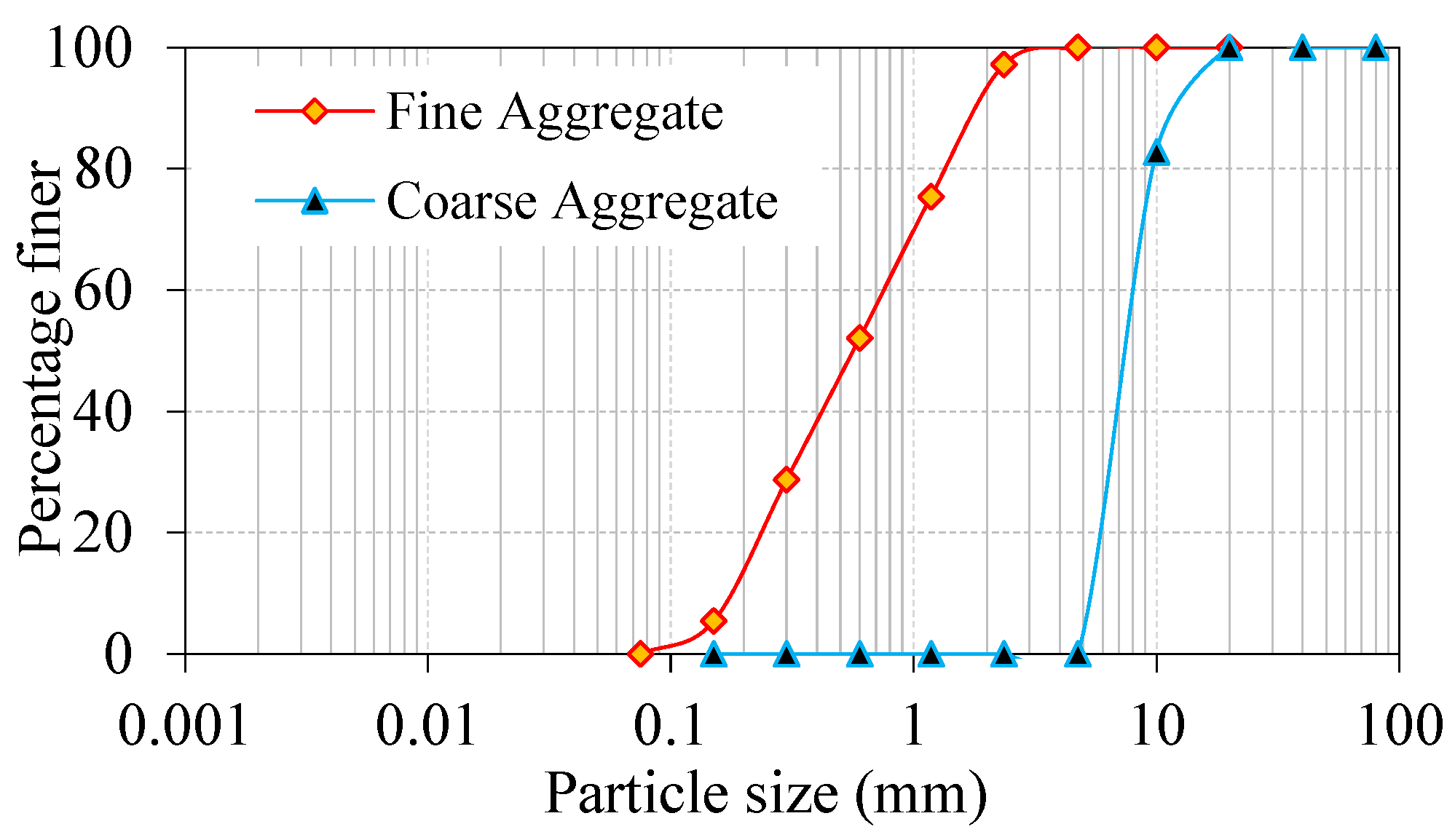
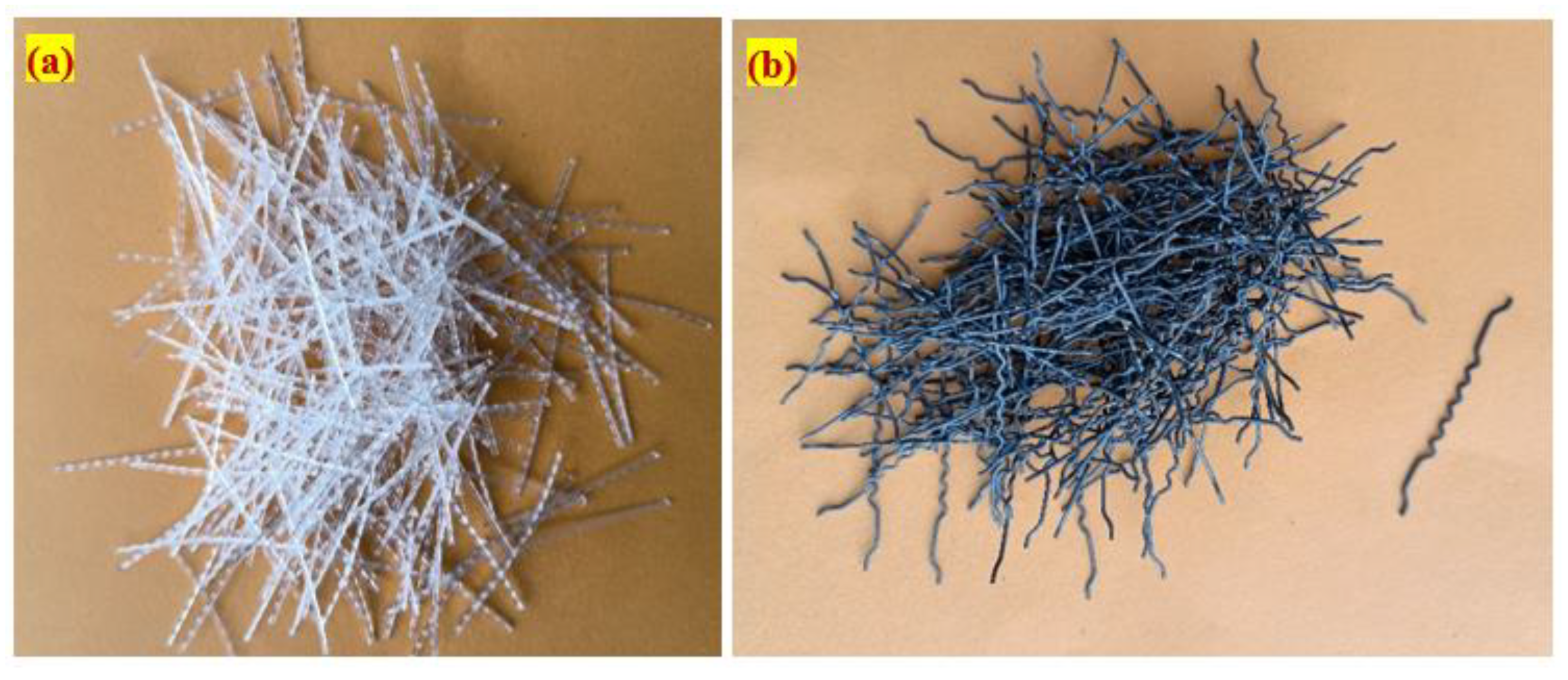
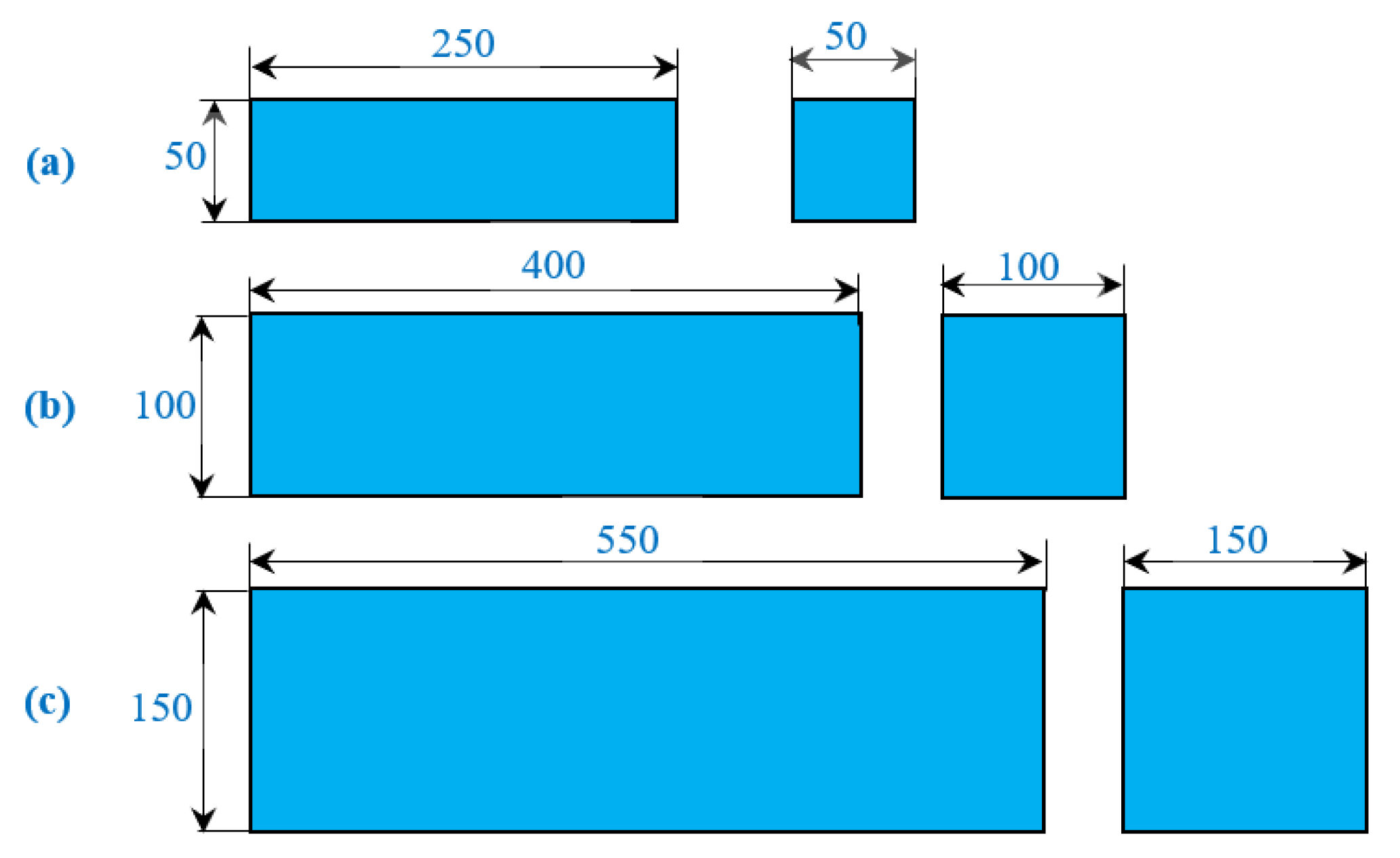

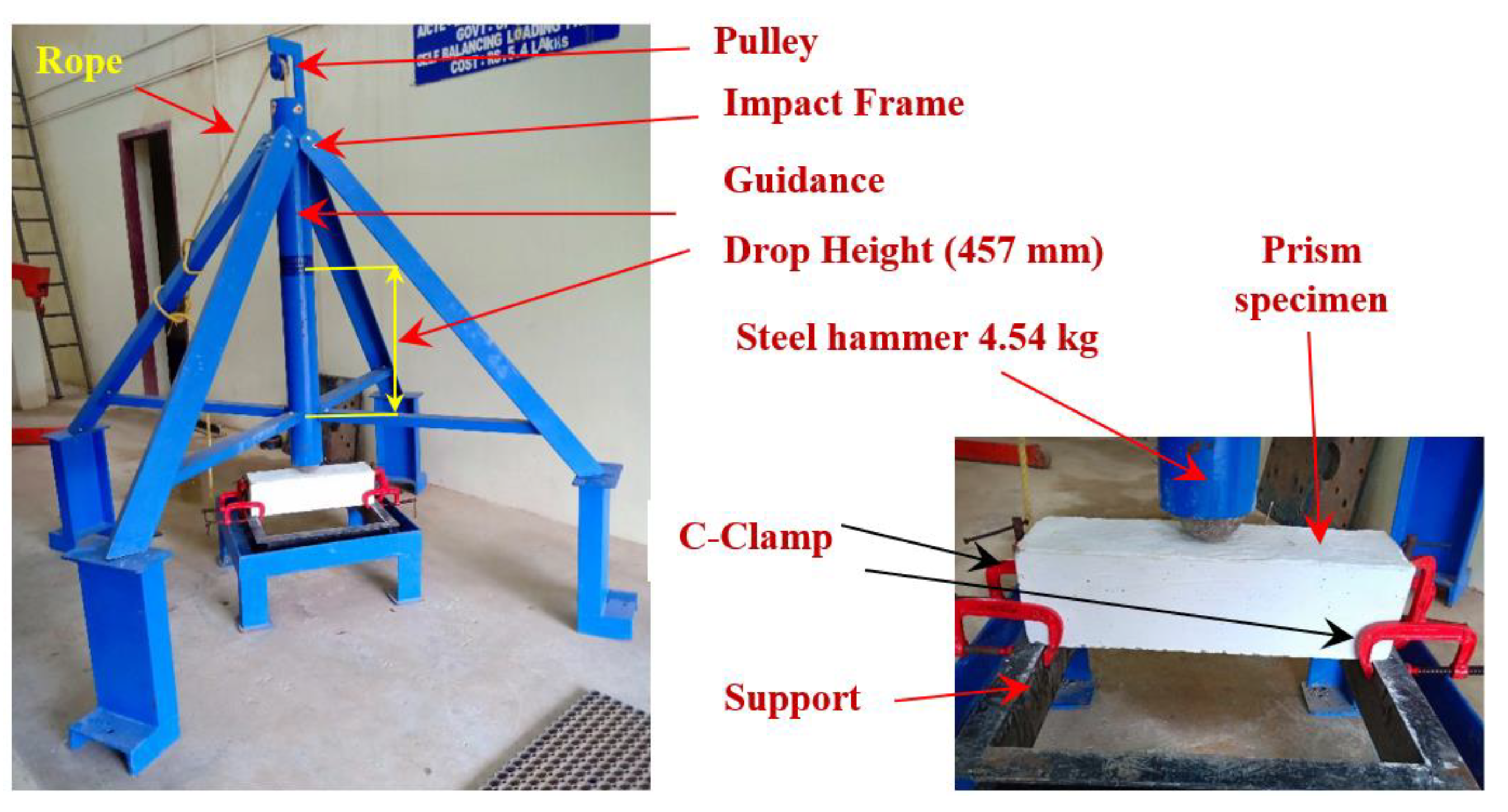

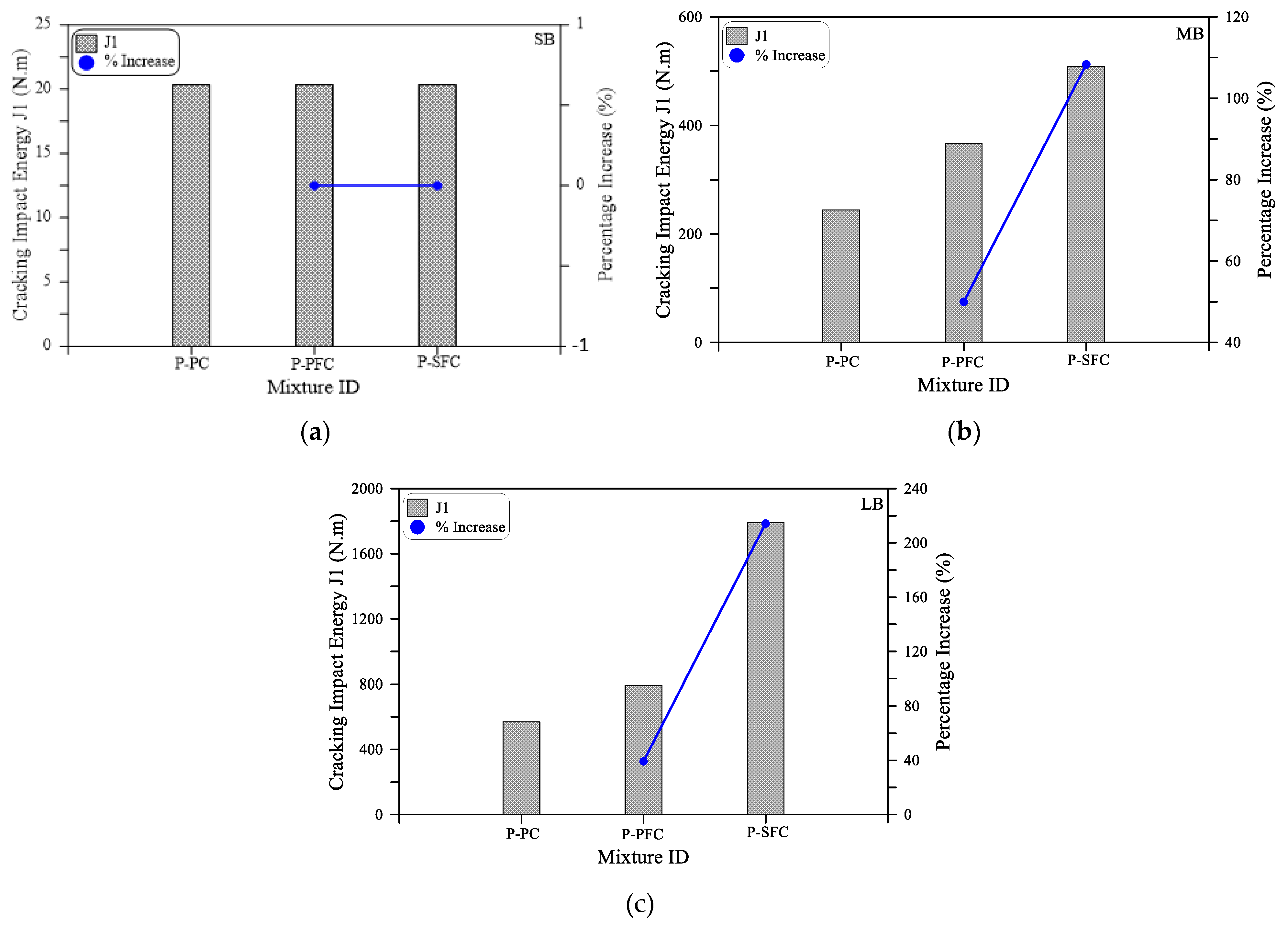
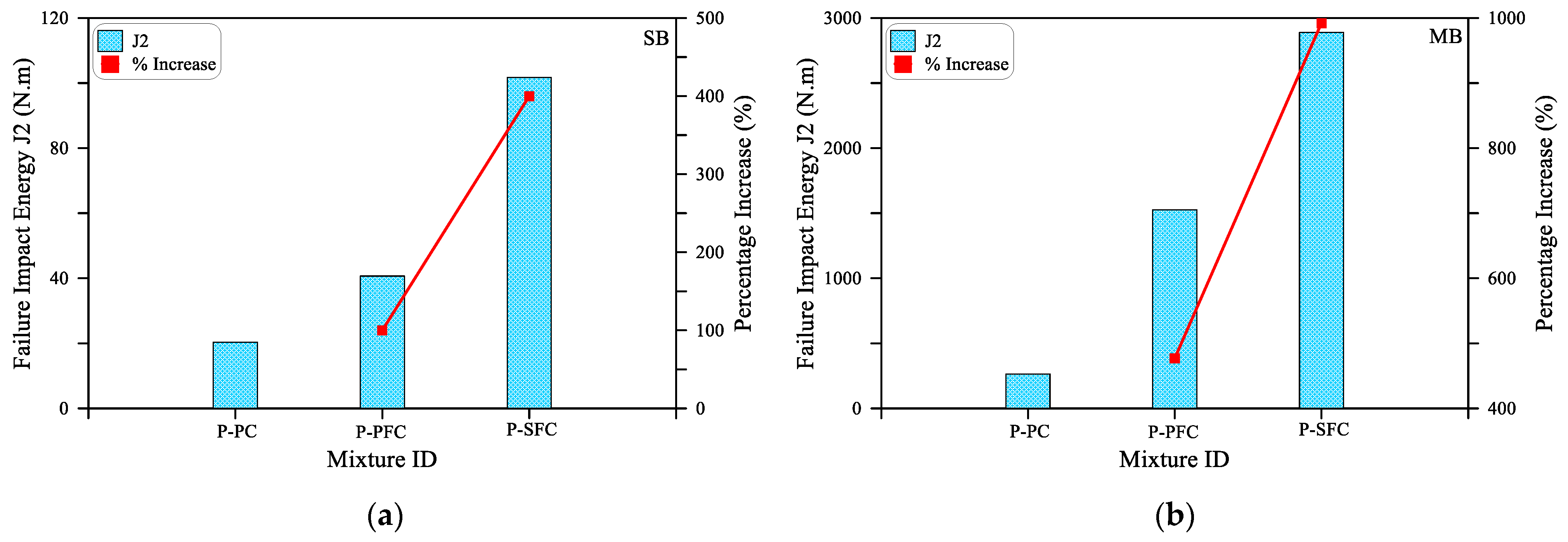


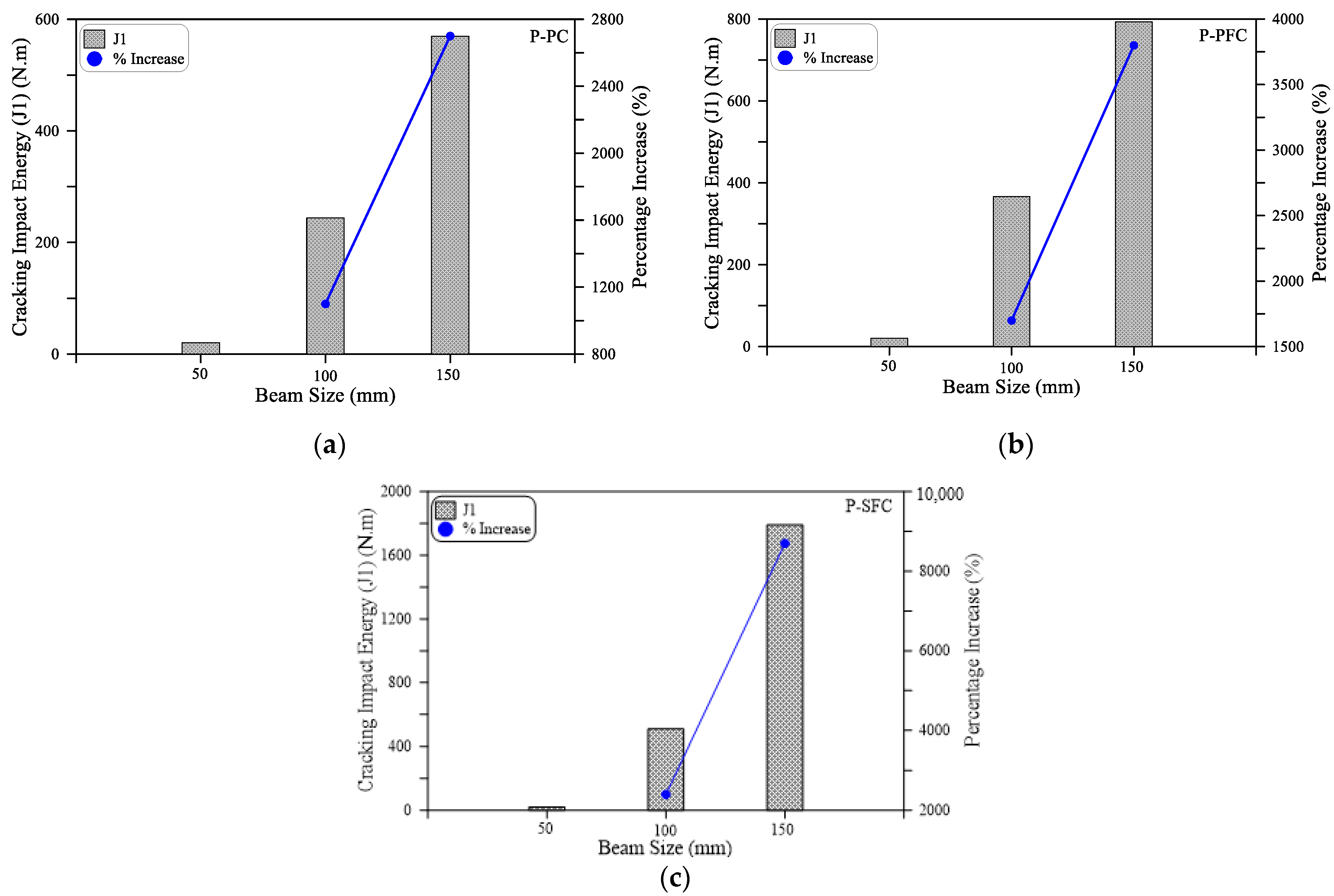
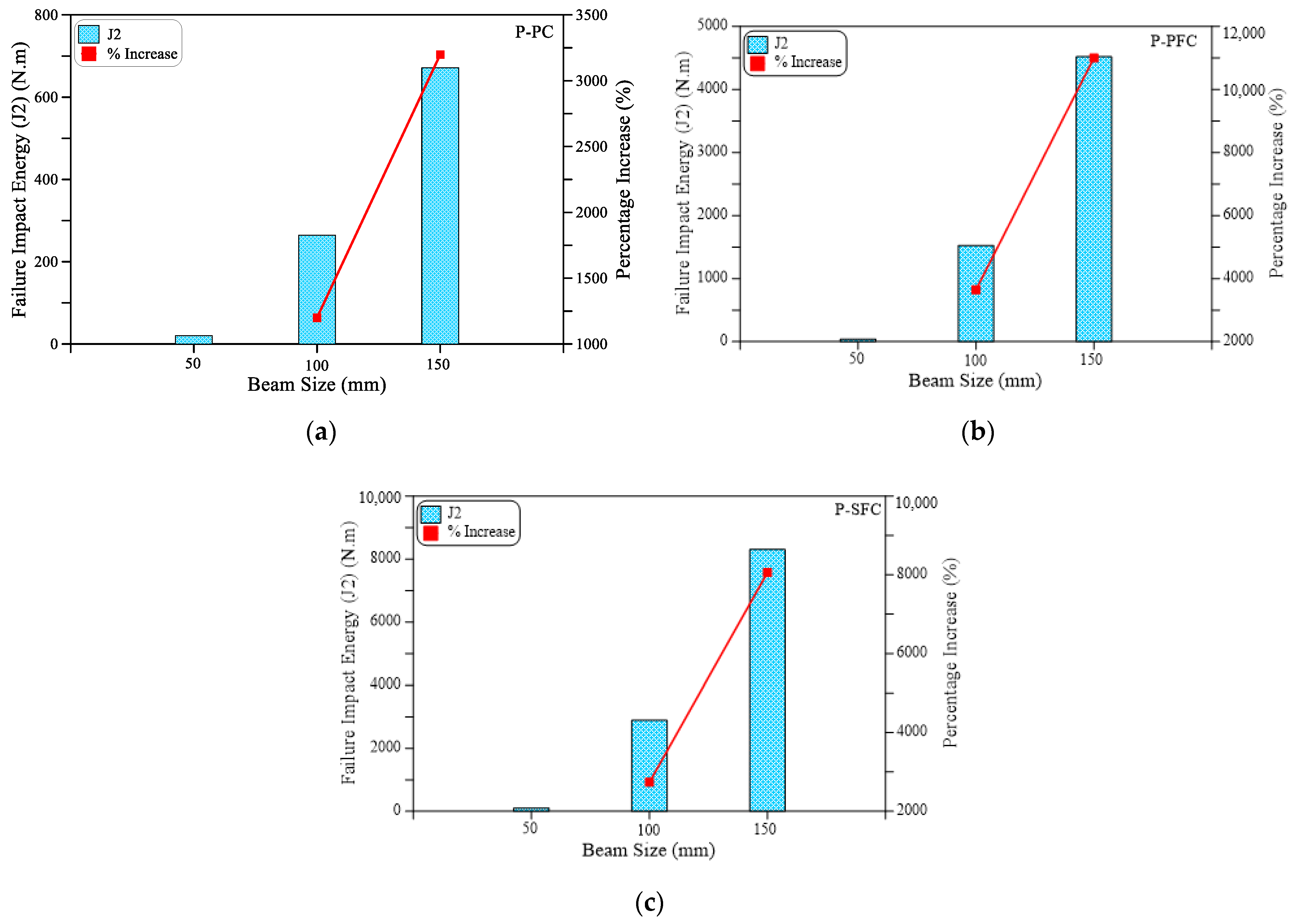
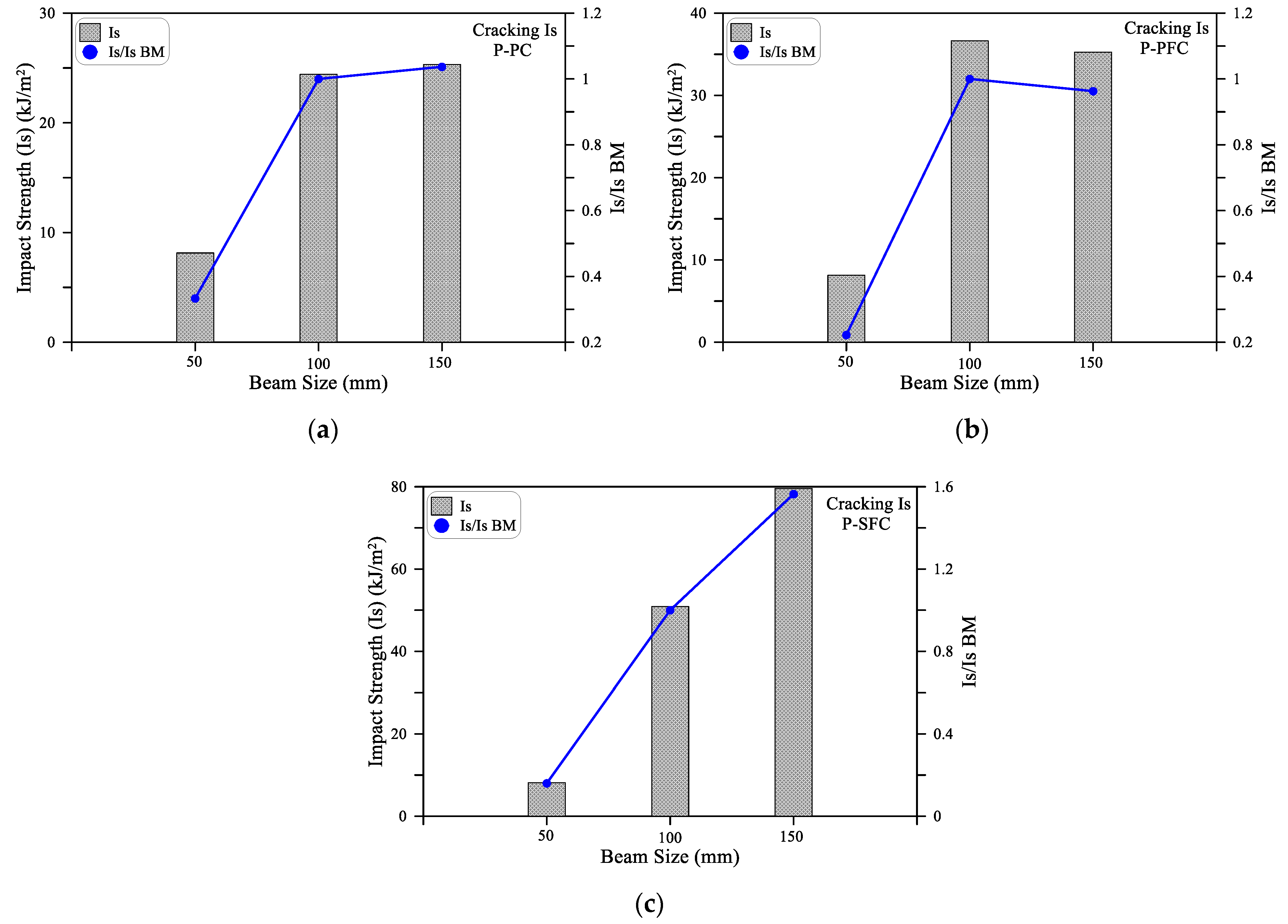
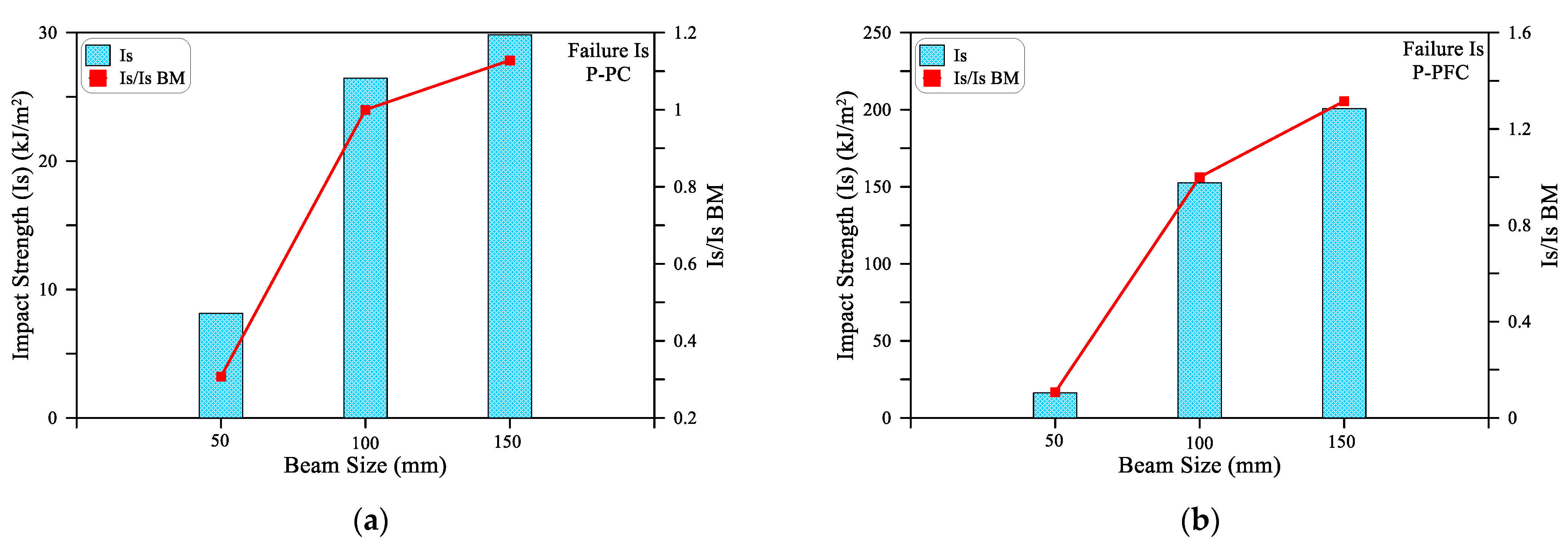
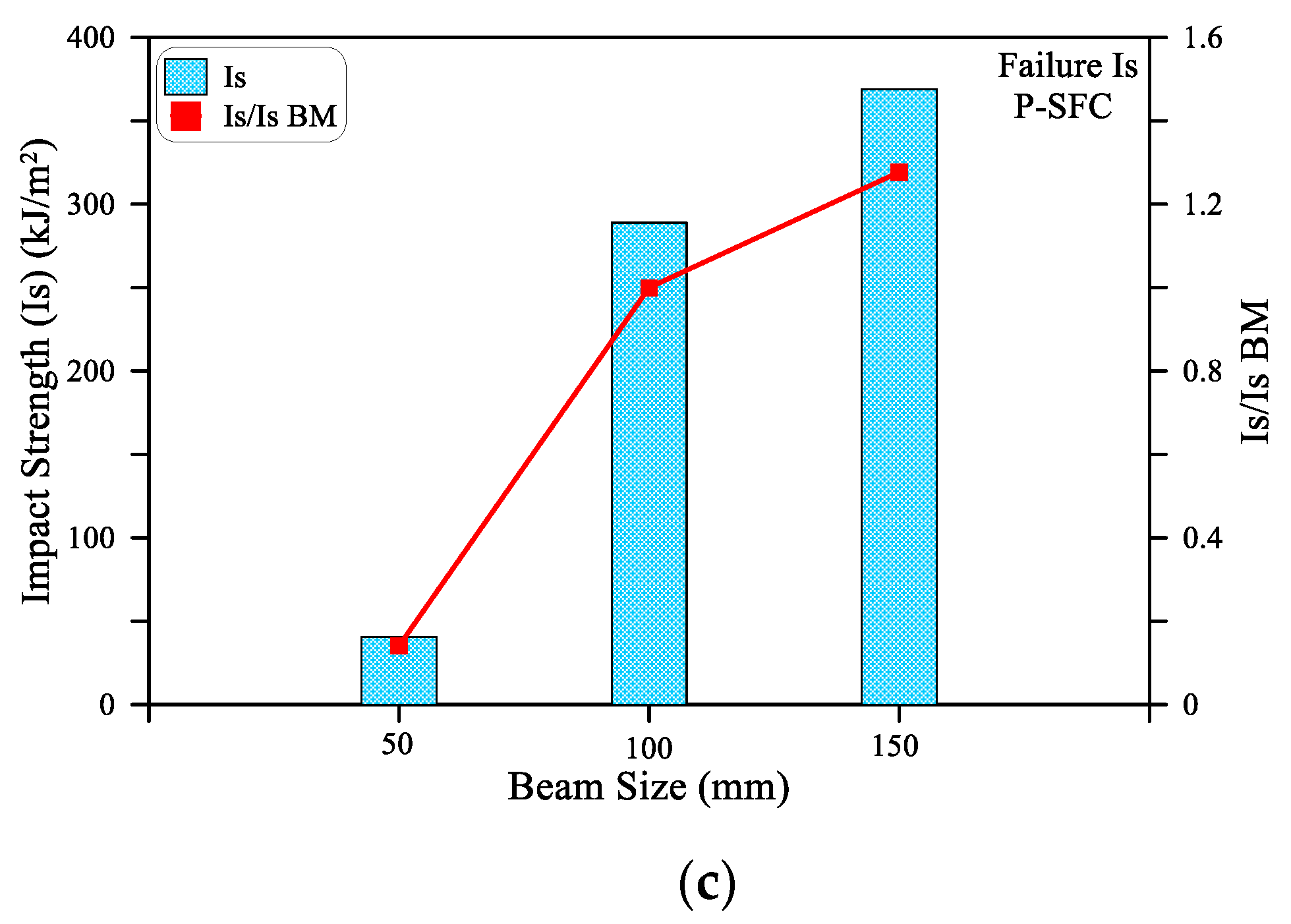
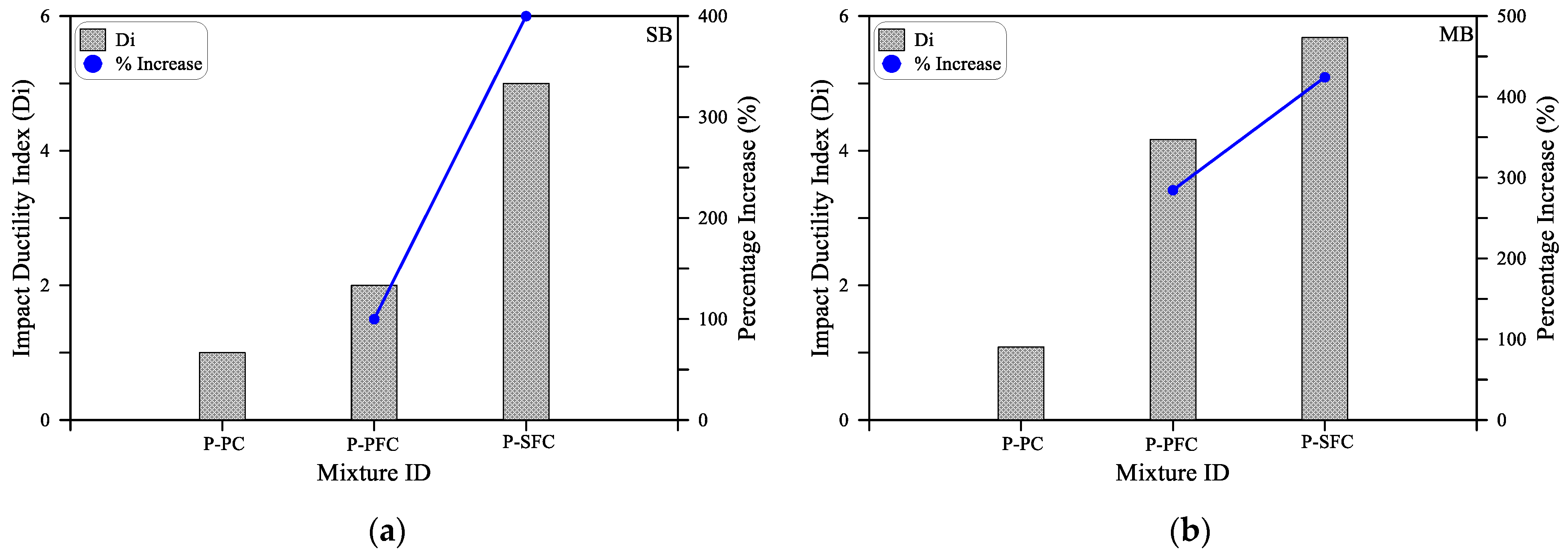
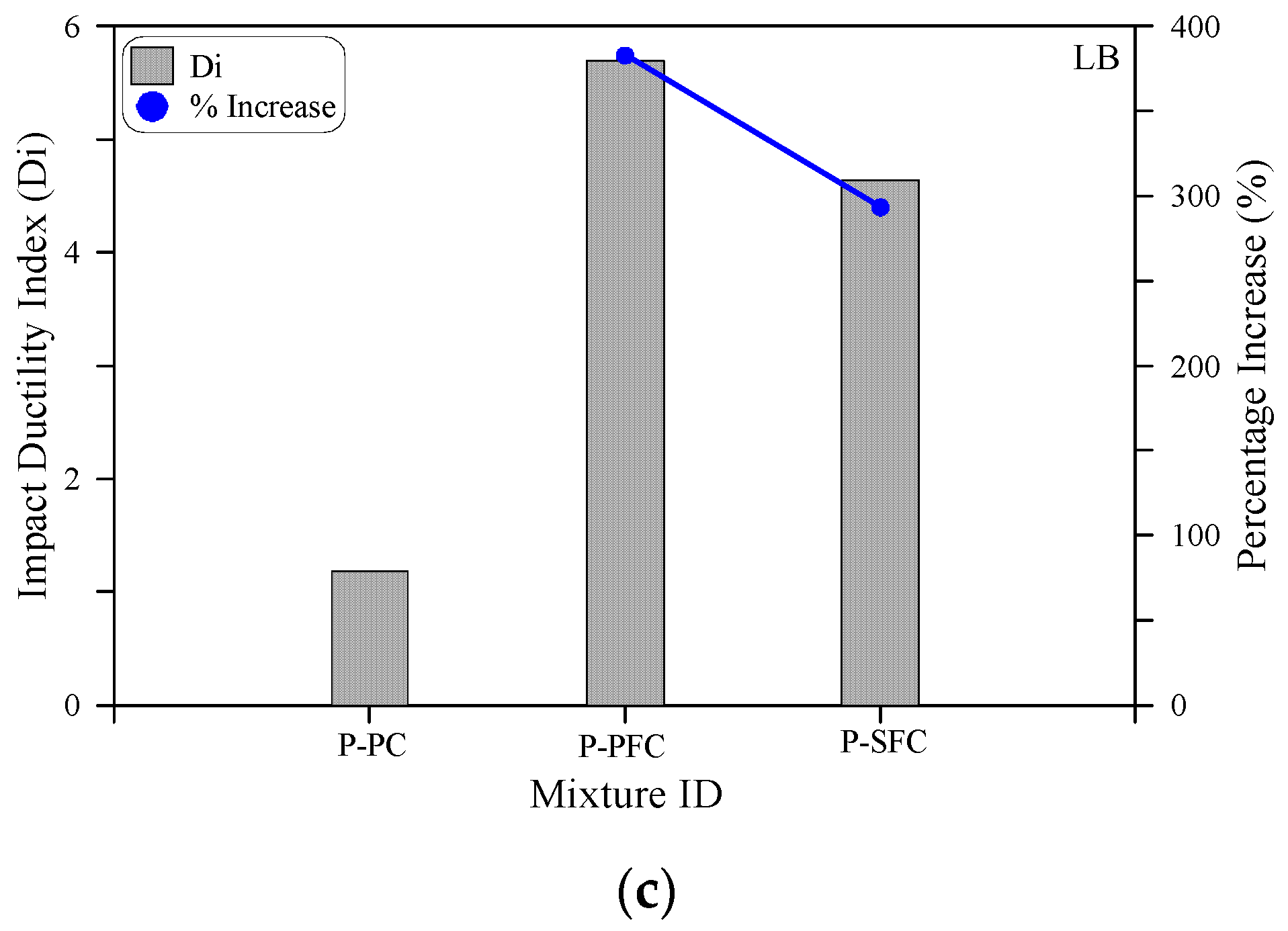
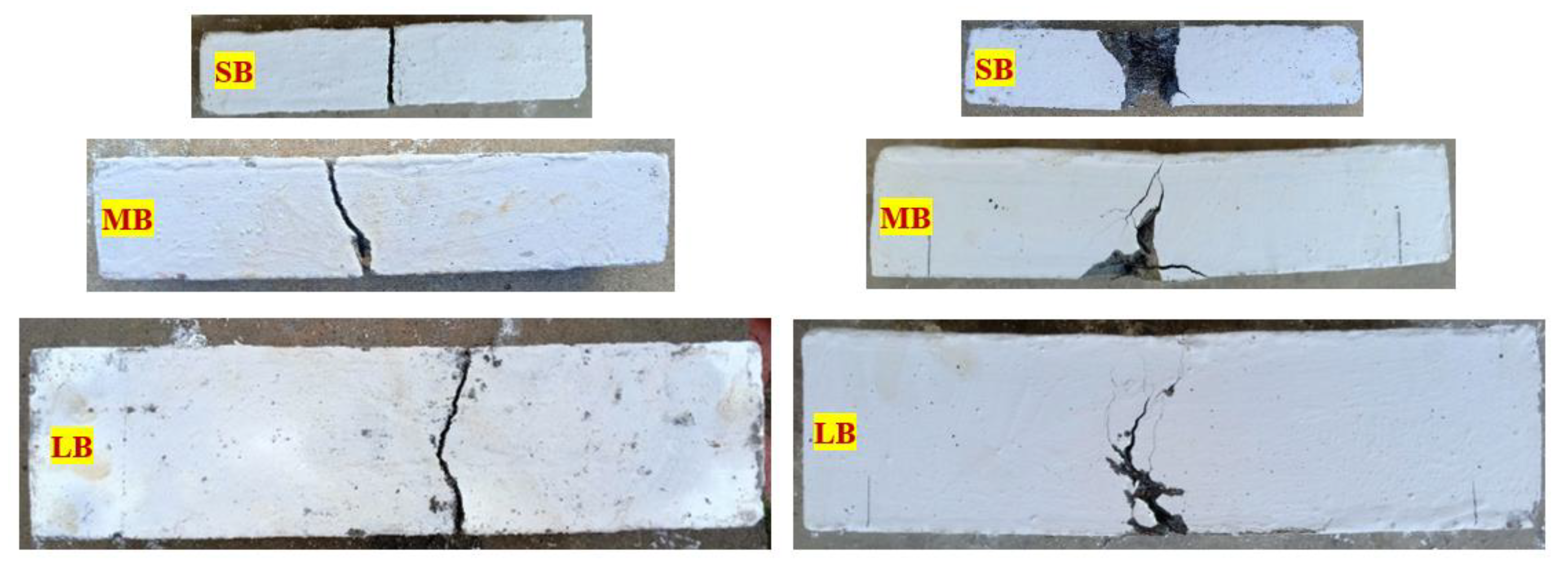
| Mixture ID | Mix Proportion of Grout for Producing 1 m3 | Coarse Aggregate (kg/m3) | Fiber Type | Fiber Dosage (%) | Superplasticizer (%) by Cement Weight | ||
|---|---|---|---|---|---|---|---|
| Cement (kg) | Sand (kg) | W/C | |||||
| P-PC | 800 | 800 | 0.42 | 1448 | - | - | 0.4 |
| P-SFC | 800 | 800 | 0.42 | 1448 | Steel | 3 | 0.6 |
| P-PFC | 800 | 800 | 0.42 | 1448 | Polypropylene | 3 | 0.6 |
| Mixture ID | Impact Number | Standard Deviation | ||||||||||
|---|---|---|---|---|---|---|---|---|---|---|---|---|
| SB | MB | LB | SB | MB | LB | |||||||
| N1 | N2 | N1 | N2 | N1 | N2 | 0 | 0 | 1.53 | 1.53 | 3.06 | 4.51 | |
| P-PC | 1 | 1 | 12 | 13 | 28 | 33 | 0 | 1 | 3.51 | 7.77 | 8.33 | 8.08 |
| P-PFC | 1 | 2 | 18 | 75 | 39 | 222 | 0 | 0 | 2.65 | 8.89 | 4.58 | 8.02 |
| P-SFC | 1 | 5 | 25 | 142 | 88 | 408 | 0 | 0 | 1.53 | 1.53 | 3.06 | 4.51 |
| Impact Energies | |||||
|---|---|---|---|---|---|
| SB | MB | LB | |||
| J1 | J2 | J1 | J2 | J1 | J2 |
| 20.35 | 20.35 | 244 | 264.49 | 570 | 671.39 |
| 20.3 | 40.69 | 366 | 1525.88 | 793 | 4516.59 |
| 20.3 | 101.73 | 509 | 2888.99 | 1790 | 8300.76 |
| Beam Size | Impact Strength is (kJ/m2) | |||||
|---|---|---|---|---|---|---|
| P-PC | P-PFC | P-SFC | ||||
| Is1 | Is2 | Is1 | Is2 | Is1 | Is2 | |
| SB | 8.1 | 8.1 | 8.1 | 16.3 | 8.1 | 40.7 |
| MB | 24.4 | 26.4 | 36.6 | 152.6 | 50.9 | 288.9 |
| LB | 25.3 | 29.8 | 35.3 | 200.7 | 79.6 | 368.9 |
| Mixture ID | Impact Energy (J) for SB | Impact Energy (J) for MB | Impact Energy (J) for LB | |||
|---|---|---|---|---|---|---|
| Experimental | Computed | Experimental | Computed | Experimental | Computed | |
| P-SFC | 101.73 | 110.88 | 2888.99 | 2697.22 | 8300.76 | 8058.46 |
| P-PFC | 40.69 | 45.51 | 1525.88 | 1493.16 | 4516.59 | 4240.49 |
Publisher’s Note: MDPI stays neutral with regard to jurisdictional claims in published maps and institutional affiliations. |
© 2022 by the authors. Licensee MDPI, Basel, Switzerland. This article is an open access article distributed under the terms and conditions of the Creative Commons Attribution (CC BY) license (https://creativecommons.org/licenses/by/4.0/).
Share and Cite
Murali, G.; Abid, S.R.; Vatin, N.I. Experimental and Analytical Modeling of Flexural Impact Strength of Preplaced Aggregate Fibrous Concrete Beams. Materials 2022, 15, 3857. https://doi.org/10.3390/ma15113857
Murali G, Abid SR, Vatin NI. Experimental and Analytical Modeling of Flexural Impact Strength of Preplaced Aggregate Fibrous Concrete Beams. Materials. 2022; 15(11):3857. https://doi.org/10.3390/ma15113857
Chicago/Turabian StyleMurali, Gunasekaran, Sallal Rashid Abid, and Nikolai Ivanovich Vatin. 2022. "Experimental and Analytical Modeling of Flexural Impact Strength of Preplaced Aggregate Fibrous Concrete Beams" Materials 15, no. 11: 3857. https://doi.org/10.3390/ma15113857
APA StyleMurali, G., Abid, S. R., & Vatin, N. I. (2022). Experimental and Analytical Modeling of Flexural Impact Strength of Preplaced Aggregate Fibrous Concrete Beams. Materials, 15(11), 3857. https://doi.org/10.3390/ma15113857








